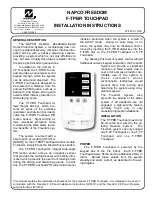
7
Wire connection using cup washers (see
Figures 3.2 and 3.3)
The use of cup washers is to prevent
wire from slipping out from under
the screw head (and/or the flat
washer).
Make sure that the cup washer is
placed between the wire and the
module frame.
Choose an adequate size for the cup
washer and the flat washer so that
the wire is fully clamped between
them.
Note: Cup washers are also called
terminal cup washers.
The cup washers should be stainless
steel, or a cup washer made of brass
may be used only if a large flat
washer made of stainless steel is
inserted between the module frame
and the cup washer.
Choose the adequate size for the
large flat washer (between the
module frame and the cup washer)
so that the cup washer doesn’t
contact the module frame and is
fixed stably to the module frame.
Method 1- Use a self-tapping machine
screw (see Figures 3.1 and 3.2)
If using this method, use one of the
smaller holes with diameter of
0.165’‘ (4.2 mm)
The self-tapping machine screw size
must be No.10 (0.190’‘ diameter
(4.83mm)).
This method requires a minimum
number
of
threads-per-inch
to
achieve
an
adequate
electrical
connection. For a single screw, the
thread pitch must be at least 32
threads per inch (TPI). A single screw
less than 32 TPI does not provide
sufficient thread contact. Note: Self-
tapping machine screws are also
called thread cutting screws.
Method 2- Use a bolt and nut (see
Figures 3.1 and 3.3)
If using this method, use one of the
larger
holes
with
diameter
of
0.205’‘ (5.2 mm)
The bolt and nut size should be No.8
(0.164’‘ diameter (4.16 mm)), or
No.10 (0.190’‘ diameter (4.83 mm))
or M5 (0.197’‘ diameter (5.0 mm)).
Star washers must be used to make
contact through the anodization of
the module for this method.
In this case, the screw threads are
not providing the electrical ground
contact.
Using lay-in lug with self tapping
machine screw
If using this method, please follow
instructions
in
previous
section
regarding
using
self-tapping
machine screws.
Use a grounding tin plated solid
copper lay-in lug rated for direct
burial and outdoor use. Lug must be
used
ILSCO
GBL-4DBT,
Burndy
CL501TN.
The self-tapping machine screw size
must be No.10 (0.190’‘ diameter
(4.83mm)).
This method requires a minimum
number
of
threads-per-inch
to
achieve
an
adequate
electrical
connection. For self-tapping machine
screws, the thread pitch must be at
least 32 threads per inch (TPI). A
single screw less than 32 TPI does
not provide sufficient thread contact.
Note: Self-tapping machine screws
are also called thread cutting screws.
As shown in figure 3.4, attach
grounding lug to module frame
using a stainless steel self-tapping
machine screw.
Insert a stainless steel star washer
between the module frame and the
lug to penetrate frame anodization.
Tighten stainless steel set screw at
the
torque
specified
by
lug
manufacturer to secure copper wire.
The specified torque is following
Ilsco
Corp.
GBL-4DBT
10-14AWG-Solid -> 20 in-lbs,
4-6AWG-Strand -> 35 in-lbs,
8AWG-Strand -> 25 in-lbs, 10-
14AWG-Strand -> 20 in-lbs
Burndy L L C CL501TN 14AWG-
Solid
->
35
in-lbs,
14AWG-Strand -> 35 in-lbs,
4AWG-Strand -> 45 in-lbs
Recommended
torque
value
in
tightening
self-tapping
machine
screw is 2.3 N.m (20in-lb).
Using a lay-in lug with bolt and nut
If using this method, please follow
instructions
in
previous
section
regarding using bolts and nuts with
larger grounding holes.
Use a grounding tin plated solid
copper lay-in lug rated for direct
burial and outdoor use. Lug must be
used
ILSCO
GBL-4DBT,
Burndy
CL501TN.
Attach grounding lug to module
frame using a stainless steel bolt and
lock-nut as shown in figure 3.5.
Tighten stainless steel set screw at
the
torque
specified
by
lug
manufacturer to secure copper wire.
Recommended
torque
value
in
tightening bolt and nut is 2.3 N.m
(20in-lb).
Using a Grounding Clip with self- tapping
machine screw
Use Tyco Electronics 1954381-1 as
grounding clip.
As shown in figure 3.6, place the
grounding clip onto the module
frame.
Thread the screw into the hole until
the head is flush with the base and
base is flush with the frame, then
tighten the screw with 1/4 to 1/2
turn.
Recommended
torque
value
in
tightening
self-tapping
machine
screw is between 2.3 and 2.8 Nm.
Insert the wire into the wire slot.
Press down on both ends of the wire.
Manually, or using channel lock
pliers, push the slider over the base
until it covers the base. This will
terminate the wire.
For more information, please refer
to Instruction sheet issued by Tyco
Electronics.
Using a Grounding Clip with bolt and nut
Use Tyco Electronics 1954381-2 as
grounding clip.
As shown in figure 3.7, place the
grounding clip onto the module
frame.
Thread the hex nut onto the end of
the screw, then using a 3/8-in.
wrench,
tighten
the
nut.
Recommended
torque
value
in
tightening bolt and nut is between
1.7 and 2.2 Nm.
Insert the wire into the wire slot.
Press down on both ends of the wire.
Manually, or using channel lock
pliers, push the slider over the base
until it covers the base. This will
terminate the wire.
For more information, please refer
to Instruction sheet issued by Tyco
Electronics.






























